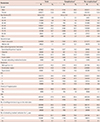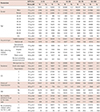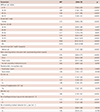1. Cade WT. Diabetes-related microvascular and macrovascular diseases in the physical therapy setting. Phys Ther. 2008; 88:1322–1335.
2. Kim HJ, Kim YA, Seo HY, Kim EJ, Yoon SJ, Oh IH. The economic burden of stroke in 2010 in Korea. J Korean Med Assoc. 2012; 55:1226–1236.
3. Heidenreich PA, Trogdon JG, Khavjou OA, et al. Forecasting the future of cardiovascular disease in the United States: a policy statement from the American heart association. Circulation. 2011; 123:933–944.
4. Kang JH, Jeong BG, Cho YG, Song HR, Kim KA. Socioeconomic costs of overweight and obesity in Korean adults. J Korean Med Sci. 2011; 26:1533–1540.
5. Brown MT, Bussell JK. Medication adherence: WHO cares? Mayo Clin Proc. 2011; 86:304–314.
6. Dreiher J, Comaneshter DS, Rosenbluth Y, Battat E, Bitterman H, Cohen AD. The association between continuity of care in the community and health outcomes: a population-based study. Isr J Health Policy Res. 2012; 1:21.
7. Vlasnik JJ, Aliotta SL, DeLor B. Medication adherence: factors influencing compliance with prescribed medication plans. Case Manager. 2005; 16:47–51.
8. Staessen JA, Wang JG, Thijs L. Cardiovascular protection and blood pressure reduction: a meta-analysis. Lancet. 2001; 358:1305–1315.
9. Jin J, Sklar GE, Min Sen Oh V, Chuen Li S. Factors affecting therapeutic compliance: a review from the patient's perspective. Ther Clin Risk Manag. 2008; 4:269–286.
10. Muszbek N, Brixner D, Benedict A, Keskinaslan A, Khan ZM. The economic consequences of noncompliance in cardiovascular disease and related conditions: a literature review. Int J Clin Pract. 2008; 62:338–351.
11. Kang HY, Yang KH, Kim YN, et al. Incidence and mortality of hip fracture among the elderly population in South Korea: a population-based study using the national health insurance claims data. BMC Public Health. 2010; 10:230.
12. Oh IH, Yoon SJ, Seo HY, Kim EJ, Kim YA. The economic burden of musculoskeletal disease in Korea: a cross sectional study. BMC Musculoskelet Disord. 2011; 12:157.
13. Sokol MC, McGuigan KA, Verbrugge RR, Epstein RS. Impact of medication adherence on hospitalization risk and healthcare cost. Med Care. 2005; 43:521–530.
14. Skaer TL, Sclar DA, Robison LM, Markowski DJ, Won JK. Effect of pharmaceutical formulation for diltiazem on health care expenditures for hypertension. Clin Ther. 1993; 15:905–911.
15. Washington DL, Harada ND, Villa VM, et al. Racial variations in Department of Veterans Affairs ambulatory care use and unmet health care needs. Mil Med. 2002; 167:235–241.
16. Hodgson TA, Cai L. Medical care expenditures for hypertension, its complications, and its comorbidities. Med Care. 2001; 39:599–615.
17. Friedman O, McAlister FA, Yun L, Campbell NR, Tu K; Canadian Hypertension Education Program Outcomes Research Taskforce. Antihypertensive drug persistence and compliance among newly treated elderly hypertensives in Ontario. Am J Med. 2010; 123:173–181.
18. Lee CY, Huang CC, Shih HC, Huang KH. Factors influencing antihypertensive medication compliance in Taiwan: a nationwide population-based study. Eur J Prev Cardiol. 2013; 20:930–937.
19. Lee DH, Choi YH, Lee KH, et al. Factors associated with hypertension control and antihypertensive medication among hypertensive patients in a community. Korean J Prev Med. 2003; 36:289–297.
20. Ren XS, Kazis LE, Lee A, Zhang H, Miller DR. Identifying patient and physician characteristics that affect compliance with antihypertensive medications. J Clin Pharm Ther. 2002; 27:47–56.
21. Patel RP, Taylor SD. Factors affecting medication adherence in hypertensive patients. Ann Pharmacother. 2002; 36:40–45.
22. Sax PE, Meyers JL, Mugavero M, Davis KL. Adherence to antiretroviral treatment and correlation with risk of hospitalization among commercially insured HIV patients in the United States. PLoS One. 2012; 7:e31591.
23. Knight EL, Bohn RL, Wang PS, Glynn RJ, Mogun H, Avorn J. Predictors of uncontrolled hypertension in ambulatory patients. Hypertension. 2001; 38:809–814.
24. Ruger JP, Kim HJ. Out-of-pocket healthcare spending by the poor and chronically ill in the Republic of Korea. Am J Public Health. 2007; 97:804–811.
25. Briesacher BA, Gurwitz JH, Soumerai SB. Patients at-risk for cost-related medication nonadherence: a review of the literature. J Gen Intern Med. 2007; 22:864–871.
26. Wald DS, Law M, Morris JK, Bestwick JP, Wald NJ. Combination therapy versus monotherapy in reducing blood pressure: meta-analysis on 11,000 participants from 42 trials. Am J Med. 2009; 122:290–300.
27. Dragomir A, Côté R, Roy L, et al. Impact of adherence to antihypertensive agents on clinical outcomes and hospitalization costs. Med Care. 2010; 48:418–425.
28. Ademi Z, Huq MM, Liew D, et al. The impact of lost therapeutic benefit (LTB) in high-risk hypertensive patients: 2-year follow-up data from the Australian REACH registry. Cardiovasc Ther. 2013; 31:370–376.







 PDF
PDF ePub
ePub Citation
Citation Print
Print



 XML Download
XML Download